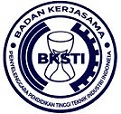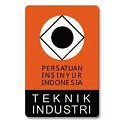Antisipasi Pencegahan Retakan Beton Pada Ruang Linac Rumah Sakit Umum Daerah Badung
Abstract
Rumah Sakit Umum Daerah Badung merupakan instansi pemerintah yang melayani fasilitas kesehatan publik, untuk meningkatkan pelayanan khususnya di bidang radio terapi, RSUD Badung akan memasang Alat Linac yang menggunakan tenaga nuklir.Alat ini merupakan alat untuk terapi kanker tanpa melakukan pembedahan dan memerlukan ruangan khusus. Ruangan khusus tersebut terbuat dari beton mutu K 500 density 2,35 ton/ m3 dengan dinding Primer tebalnya 2,5 meter, dinding sekunder 1,5 meter, dak atap 3,5 meter dan beton tidak boleh retak. Tujuan penelitian adalah: Untuk mengetahui karakteristik beton tidak retak, dan juga untuk mengetahui langkah yang diambil dalam mengantisipasi keretakan beton pada ruang linac tersebut. Lokasi penelitian di 3 batching plan dan 1 di lokasi pembangunan Ruang Linac Rumah Sakit Umum Daerah Badung. Metode penelitian dengan mengumpulkan data primer yang didapat langsung di lapangan dan data sekunder di dapat dari vendor baik suplayer maupun laboratorium. Hasil penelitian ini adalah untuk memenuhi persyaratan beton mutu tinggi K-500 density 2,35 ton/m³ digunakan material lokal baik agregat halus maupun agregat kasar yang diambil dari Grogak Singaraja, material ini dihasilkan dari pemecahan batu kali sehingga berat jenis materialnya tinggi, keausan kecil, penyerapan kecil, kuat tekan nya tinggi serta kandungan lumpurnya dibawah 1 %.Untuk menurunkan suhu beton awal sampai 4℃ digunakan air dengan dicampur es balok. Pengendalikan dan pengawasan sumber daya manusia saat pengecoran harus benar diperhattikan, mengingat faktor tenaga kerja akan mempengaruhi kwalitas beton, dan melakukan curing dengan merendam beton setelah 3 jam pengecoran (saat beton mulai mengeras).
Full Text:
PDFReferences
T. C. Nguyen, “Prevention of crack formation in massive concrete at an early age by cooling pipe system,” Asian J. Civ. Eng., vol. 20, no. 8, pp. 1101–1107, 2019, doi: 10.1007/s42107-019-00175-5.
T. M. Sari and W. Dini, “Risk Assessment and Mitigation Strategy in The Halal Broiler Supply Chain,” J. Ris. Ilmu Tek., vol. 1, no. 1, pp. 13–24, 2023.
F. Pohan, I. Saputra, and R. Tua, “Scheduling Preventive Maintenance to Determine Maintenance Actions on Screw Press Machine,” J. Ris. Ilmu Tek., vol. 1, no. 1, pp. 1–12, 2023.
G. Zhang, “Reviews on temperature control and crack prevention of high concrete dam,” Shuili Xuebao/Journal of Hydraulic Engineering, vol. 49, no. 9. pp. 1068–1078, 2018. doi: 10.13243/j.cnki.slxb.20180687.
J. Liu, “Toughening and crack prevention of modern concrete: mechanisms and applications,” Tumu Gongcheng Xuebao/China Civ. Eng. J., vol. 54, no. 10, 2021, [Online]. Available: https://api.elsevier.com/content/abstract/scopus_id/85117115102
I. N. Permadi and D. B. Nisa, “A Model Experiment Design Using the Taguchi Method: A Case Study Of Making Concrete Roof,” J. Ris. Ilmu Tek., vol. 1, no. 1, pp. 36–44, 2023.
D. P. Sari, “Business Feasibility Analysis of Sumedang Tofu MSMEs with Value Engineering Approach,” J. Econ. Bus. Ind., vol. 1, no. 1, pp. 20–31, 2023.
H. A. Ramadhan, “Determinants of Economic Value Addition of Industrial Tuna Fish Processors in the Sea Food Processing Sub-Chain in Malaysia,” J. Econ. Bus. Ind., vol. 1, no. 1, pp. 43–49, 2023.
K. Hu, “Shear Stress Analysis and Crack Prevention Measures for a Concrete-Face Rockfill Dam, Advanced Construction of a First-Stage Face Slab, and a First-Stage Face Slab in Advanced Reservoir Water Storage,” Adv. Civ. Eng., vol. 2018, 2018, doi: 10.1155/2018/2951962.
G. Zhang, “Intelligent monitoring and control system for crack prevention of mass concrete,” Adv. Sci. Technol. Water Resour., vol. 35, no. 5, pp. 83–88, 2015, doi: 10.3880/j.issn.1006-7647.2015.05.011.
X. Pan, “Dynamic optimal analysis of concrete temperature control and crack prevention standards and measures during dam construction for Zangmu Hydropower Station,” J. Hohai Univ., vol. 43, no. 4, pp. 300–306, 2015, doi: 10.3876/j.issn.1000-1980.2015.04.004.
Y. Tan, “Crack mechanism and prevention measures of concrete in the initial pouring based on field temperature gradient experiment,” IOP Conference Series: Earth and Environmental Science, vol. 153, no. 5. 2018. doi: 10.1088/1755-1315/153/5/052021.
N. R. dos Santos, “Towards sustainable reinforced concrete beams: multi-objective optimization for cost, CO2 emission, and crack prevention,” Asian J. Civ. Eng., 2023, doi: 10.1007/s42107-023-00795-y.
S. Ma, “Study on Temperature Control and Crack Prevention Scheme for Lining Concrete Construction of Spillway Tunnel in Summer,” Journal of Physics: Conference Series, vol. 2185, no. 1. 2022. doi: 10.1088/1742-6596/2185/1/012053.
R. Gustiari, “JEBIN Journal of Economics Business Industry”.
B. Chen, “Long term monitoring for insulation and thermal crack prevention on a concrete arch gravity dam in cold region,” 9th International Conference on Structural Health Monitoring of Intelligent Infrastructure: Transferring Research into Practice, SHMII 2019 - Conference Proceedings, vol. 1. pp. 112–118, 2019. [Online]. Available: https://api.elsevier.com/content/abstract/scopus_id/85091466083
D. Guo, “Research on the Temperature Control and Crack Prevention of A one-hundred-meter-long Complex Slab Concrete under the Constraint of Diaphragm Wall,” 2021 7th International Conference on Hydraulic and Civil Engineering and Smart Water Conservancy and Intelligent Disaster Reduction Forum, ICHCE and SWIDR 2021. pp. 497–501, 2021. doi: 10.1109/ICHCESWIDR54323.2021.9656488.
G. Filhaq, S. Aprianto, and H. Alfianto, “Design of Smart Locker Door Using Quality Function Deployment Based on ATMega 2560 Microcontroller,” J. Ris. Ilmu Tek., vol. 1, no. 1, pp. 25–35, 2023.
N. Shi, “Simulation and Modelling in Cracks Prevention of Early Age Concrete,” IOP Conference Series: Materials Science and Engineering, vol. 562, no. 1. 2019. doi: 10.1088/1757-899X/562/1/012014.
DOI: http://dx.doi.org/10.24014/jti.v9i2.24770
Refbacks
- There are currently no refbacks.
Copyright (c) 2023 I Putu Ariawan, I Ketut Sukarata, I Ketut Nuraga

This work is licensed under a Creative Commons Attribution-NonCommercial-ShareAlike 4.0 International License.
Jurnal Teknik Industri
P-ISSN 2460-898X | E-ISSN 2714-6235
Published by:
Industrial Engineering Department
Universitas Islam Negeri Sultan Syarif Kasim Riau, Indonesia
Office Address:
H.R. Soebrantas KM 15.5, Tampan, Pekanbaru, Riau, Indonesia 28293
email: jti.fst@uin-suska.ac.id
Indexed by:
JTI : Jurnal Teknik Industri under a Creative Commons Attribution-NonCommercial-ShareAlike 4.0 International License.

















